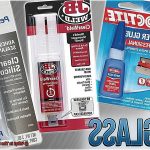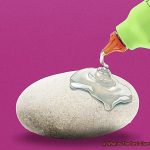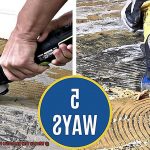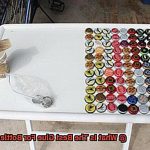Are you ready to take your DIY projects to the next level? Bottle caps are the secret ingredient that can add a splash of whimsy and personality to any wooden masterpiece. From revamping old furniture to crafting eye-catching wall art, these little metallic wonders have the power to transform ordinary wood into extraordinary works of art.
But here’s the catch: finding the perfect glue for securely attaching bottle caps to wood is no easy task. You want an adhesive that will stand the test of time, ensuring your creations stay intact for years to come. That’s where we come in. We’ve done our homework, consulted with experts, and uncovered the answer to that burning question: What is the best glue for bottle caps on wood?
In this comprehensive guide, we dive headfirst into the world of adhesives, revealing the top contenders that promise durability, flexibility, and ease of use. Whether you’re a seasoned crafter or just dipping your toes into the DIY pool, we’ve got you covered. Get ready as we unveil the ideal glue for your bottle cap masterpieces, giving you the confidence to tackle your next project with gusto.
So let’s get started. Together, we’ll explore a realm of adhesive possibilities and unlock secrets that will bring your bottle cap and wood creations from mere ideas to jaw-dropping reality. Get ready to unleash your creativity like never before.
What to Consider When Choosing the Right Glue
Contents
- 1 What to Consider When Choosing the Right Glue
- 2 Advantages of Using Epoxy Resin
- 3 Super Glue: Its Fast-Drying Bonding Properties
- 4 The Benefits of Using a Hot Glue Gun
- 5 Tips for Applying Adhesive to Bottle Caps and Wood
- 6 Common Mistakes When Gluing Bottle Caps on Wood
- 7 Important Safety Precautions for Working with Glues
- 8 Conclusion
When it comes to choosing the right glue for attaching bottle caps to wood, there are several factors to consider. The type of glue you use can greatly affect the durability and longevity of the bond between the bottle caps and the wood surface. Here are some important things to keep in mind when selecting a glue for this specific application:
Adhesive Strength
The adhesive strength of the glue is crucial for creating a strong and reliable bond between the bottle caps and the wood. Look for glues that are specifically designed for bonding different materials, such as metal to wood or plastic to wood. These specialized glues often have superior adhesive properties and are more suitable for securing bottle caps onto wood surfaces.
Compatibility
It is essential to ensure that the glue you choose is compatible with both the bottle caps and the wood surface. Different materials may require different types of adhesives. For example, if your bottle caps are made of metal, you may need a glue that is specifically designed to bond metal to wood. Similarly, if your bottle caps are made of plastic, you should opt for a glue that is compatible with both plastic and wood.
Drying Time
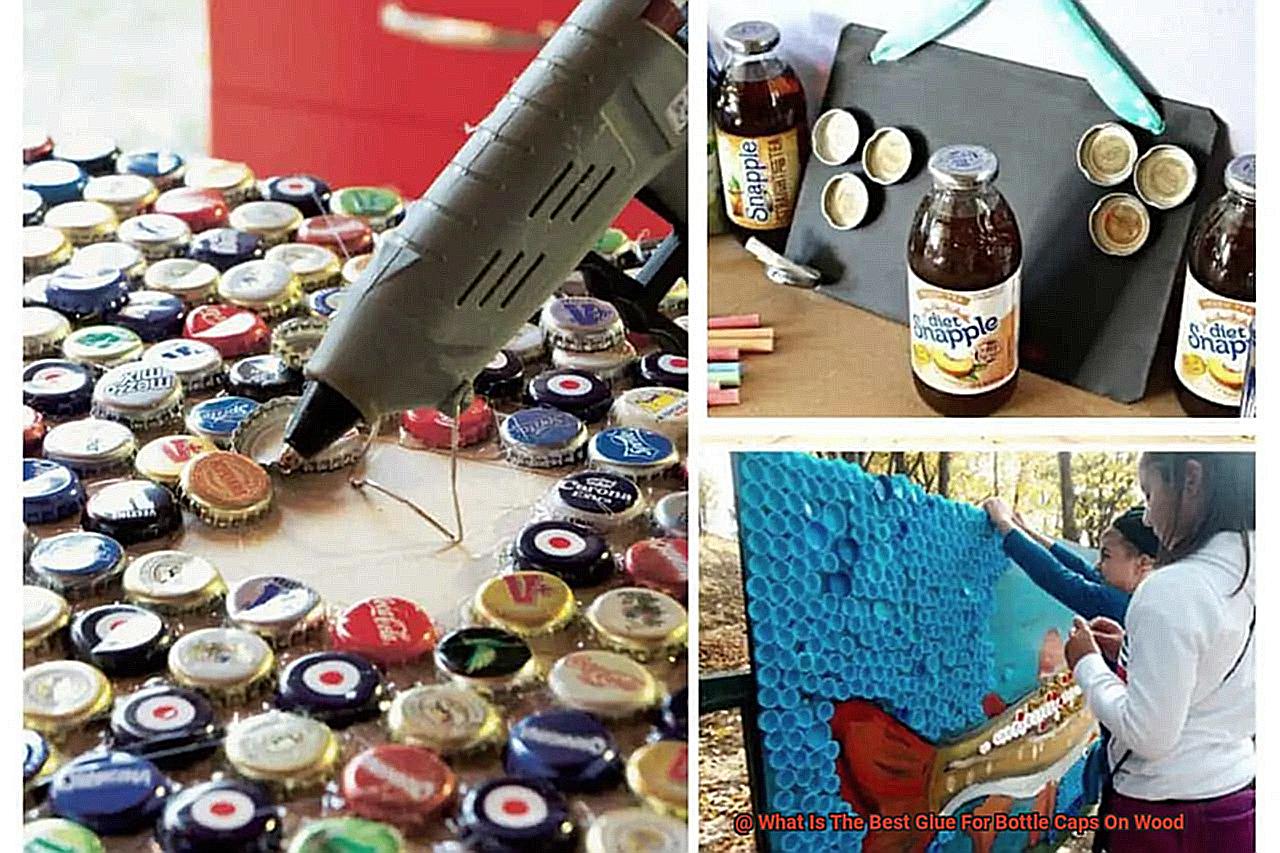
Consider the drying time of the glue you choose. Depending on your project’s timeline, you may prefer a fast-drying adhesive that allows you to move on quickly. However, keep in mind that some fast-drying glues may sacrifice adhesive strength. It’s important to find a balance between drying time and adhesive performance that suits your specific needs.
Waterproof or Weatherproof Properties
If your bottle cap project will be exposed to moisture or weather conditions, it is crucial to select a glue with waterproof or weatherproof properties. This will ensure that the bond remains intact even in damp environments or when subjected to temperature variations. Look for glues that explicitly state their resistance to water or weather elements.
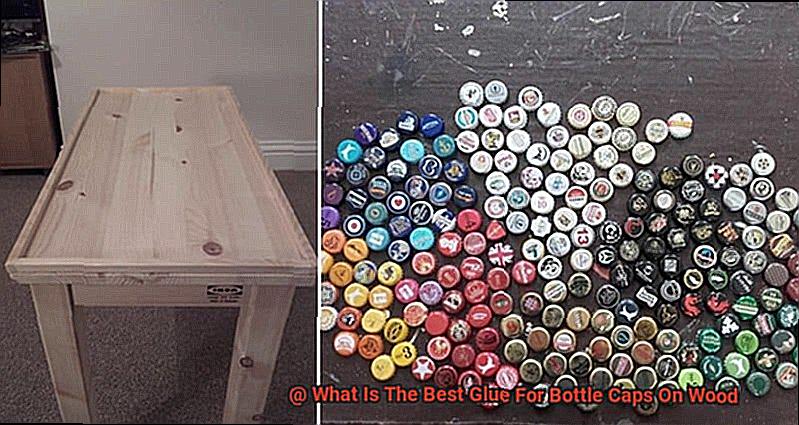
Application Method
Consider the ease of application when choosing a glue. Some glues come in convenient squeeze bottles or applicator pens, while others may require a separate applicator tool. Choose a glue that allows for precise and effortless application to ensure a clean and neat attachment of the bottle caps to the wood surface.
Longevity
Think about the long-term durability you desire for your project. If you want the bottle caps to remain securely attached to the wood for an extended period, consider selecting a glue that offers long-lasting adhesive strength. Some glues are specifically formulated for permanent bonding, while others may be more suitable for temporary or removable applications.
By considering these factors, you can make an informed decision about the glue that will work best for attaching bottle caps to wood surfaces.
Advantages of Using Epoxy Resin
Epoxy resin is a powerful adhesive that offers numerous advantages when it comes to attaching bottle caps to wood. Its exceptional adhesive properties create a strong bond that withstands moisture and temperature changes, ensuring that the caps remain securely in place over time. This makes epoxy resin an ideal choice for securing bottle caps onto wooden surfaces.
In addition to its strong bonding capability, epoxy resin is also highly durable. Once cured, it forms a hard and resilient surface that can handle heavy use, impact, and other forms of wear and tear. This means that the bottle caps will stay firmly attached to the wood, even in high-traffic areas or when subjected to rough handling.
Another advantage of using epoxy resin is its versatility. It can be used on various types of wood surfaces, such as plywood, hardwood, and engineered wood. It can also adhere to different materials commonly used for bottle caps, including metal, plastic, or glass. This versatility allows for greater flexibility in design and ensures that the epoxy resin can be used across a wide range of applications.
Furthermore, epoxy resin dries to a clear and transparent finish, which enhances the overall aesthetics of the bottle caps. The clear finish allows the natural beauty of the wood grain to show through, creating an attractive and visually appealing appearance.
Epoxy resin also offers excellent chemical resistance properties. This makes it suitable for applications where the bottle caps may come into contact with liquids or substances that could potentially damage other types of adhesives. The chemical resistance ensures that the glue remains intact and unaffected by common household liquids such as water, oils, or cleaning agents.
Lastly, applying epoxy resin is relatively easy. It comes in two parts – the resin and the hardener – which are mixed together before application. The mixed epoxy can then be spread onto the wood surface using a brush or spatula. This ease of application allows for hassle-free and efficient bonding of bottle caps to wood.
Super Glue: Its Fast-Drying Bonding Properties
Super glue, also known as cyanoacrylate adhesive, is a remarkable adhesive that offers fast-drying bonding properties. It is particularly popular for attaching bottle caps to wood surfaces due to its quick adhesion and reliable strength. Let’s dive deeper into the reasons why super glue is the go-to choice for this task.
First and foremost, super glue is known for its rapid bonding capabilities. Within seconds of application, it starts to polymerize and form strong molecular bonds. This means that when you apply it to a wooden surface, the bottle caps are securely attached almost instantly. This speedy bonding process eliminates the need for clamps or extended drying times, making it incredibly convenient.
In addition to its rapid bonding, super glue is also highly versatile. It has the ability to bond different materials together effectively. Whether your bottle caps are made of metal or plastic, super glue adheres well to both porous and non-porous surfaces. This versatility ensures that no matter the material of your bottle caps, they will stay firmly in place on the wood surface.
Moreover, once fully cured, super glue forms an incredibly strong and durable bond. It can withstand significant stress and forces, ensuring that your bottle caps remain securely attached even with regular use or handling. You can trust that your bottle caps will stay in place for the long haul.
However, it is essential to consider certain factors that may impact the bonding performance of super glue. The type of wood, the material of the bottle caps, and proper surface preparation are all key factors to take into account. To ensure optimal adhesion, it is advisable to clean and prepare the surfaces before applying the super glue.
The Benefits of Using a Hot Glue Gun
When it comes to attaching bottle caps to wood surfaces, using a hot glue gun offers a wide array of benefits. Let’s delve into these advantages in more detail:
- Quick Drying Time: Unlike other glues that can take hours or even days to dry, hot glue dries within minutes. This fast drying time allows you to continue working on your project without any delays, ensuring efficient and timely completion.
- Strong Bond: Hot glue is renowned for its strong bond. It forms a solid and durable connection between the bottle caps and the wood surface, guaranteeing that they stay in place even with frequent handling or exposure to movement. This is particularly crucial when attaching bottle caps to wood, as they may endure various stresses over time.
- Ease of Use: Hot glue guns are incredibly simple to use. They are lightweight and designed for comfortable handling, making them suitable for both beginners and experienced crafters. With just a simple squeeze of the trigger, you can apply the glue precisely where needed, ensuring a clean and neat attachment.
- Cost-Effective: Hot glue guns are relatively inexpensive compared to other adhesive options. They are widely available at affordable prices, making them a cost-effective choice for attaching bottle caps to wood surfaces. This allows you to complete your project without breaking the bank.
- Safety: Hot glue is generally safe to use. While caution should be exercised when handling the heated glue, once it cools down, it becomes non-toxic and safe for most applications. This makes it suitable for projects involving children or pets, providing peace of mind while crafting.
In addition to these benefits, hot glue guns offer even more advantages:
- Versatility: Hot glue guns can bond various materials, not just bottle caps and wood. They can adhere to fabrics, plastics, metals, and more, making them a versatile option for different crafting needs. This means that you can use the hot glue gun for a wide range of projects beyond attaching bottle caps to wood.
- Bonding on Uneven Surfaces: Hot glue bonds quickly and firmly to uneven surfaces. If your wood surface has bumps or grooves, the hot glue can fill in those gaps and create a secure attachment between the bottle caps and the wood. This ensures a strong bond even on imperfect surfaces.
- Reversibility: Hot glue is reversible, allowing for easy adjustments and flexibility in your project. If you make a mistake or want to remove the bottle caps from the wood surface in the future, you can easily heat up the glue again and peel it off without causing damage to the materials.
Tips for Applying Adhesive to Bottle Caps and Wood
Applying adhesive to bottle caps and wood can be a tricky task, but with the right tips and techniques, you can ensure a strong and durable bond. Here are five tips to help you achieve the best results:
Clean the Surfaces
Before applying adhesive, it is important to clean both the bottle caps and the wood surface. Use a clean cloth or paper towel to wipe away any dirt, dust, or debris. This will ensure that the adhesive can bond properly and create a strong attachment.
Choose the Right Adhesive
Selecting the correct adhesive is crucial for a successful bond between bottle caps and wood. Look for an adhesive that is specifically designed for bonding different materials, such as wood and metal. Epoxy adhesives are often recommended as they provide a strong and durable bond.
Roughen Up the Surfaces
To enhance the bonding strength of the adhesive, it is advisable to roughen up the surfaces that will be bonded. Use fine-grit sandpaper to lightly sand both the bottle caps and the wood. This creates a rougher surface that allows the adhesive to grip better.
Apply Adhesive to One Surface at a Time
To ensure an even application, it is best to apply the adhesive to one surface at a time. Use a small brush or applicator to spread the adhesive evenly over the surface of either the bottle cap or the wood. Make sure to cover the entire surface with a thin and even layer of adhesive.
Press Bottle Caps onto Wood
After applying the adhesive, carefully press the bottle caps onto the wood surface. Apply even pressure to ensure that the adhesive makes good contact with both surfaces. You can use your hands or a clamp to hold the bottle caps in place while the adhesive cures.
Common Mistakes When Gluing Bottle Caps on Wood
Gluing bottle caps onto wood surfaces can be a fun and creative way to add unique designs and patterns to your woodworking projects. However, there are common mistakes that people often make when attempting this technique. By being aware of these mistakes and taking the necessary precautions, you can achieve the best possible results.
One of the most common mistakes is using the wrong type of glue. Not all glues are designed to bond metal to wood, so it is important to choose a glue specifically formulated for this purpose. Epoxy or cyanoacrylate (super glue) are excellent choices as they have strong adhesive properties that ensure a durable and long-lasting bond.
Applying too much or too little glue is another mistake to avoid. Using excessive amounts of glue can result in messy and uneven results, while using too little will lead to a weak bond. It is important to follow the manufacturer’s instructions regarding the amount of glue to use. Typically, a thin and even layer of glue spread over the surface is sufficient for a secure attachment.
Properly preparing the surface before gluing is crucial for achieving a strong bond. Wood surfaces should be clean, dry, and free from any dust or debris that may interfere with the bonding process. It is recommended to lightly sand the surface to create a rough texture, which allows for better adhesion between the glue and the wood.
Rushing the drying time is a common mistake that can compromise the strength of the bond. It is important to allow sufficient drying time as specified by the adhesive manufacturer before handling or moving the glued bottle caps. Rushing this process can result in a weak bond that easily breaks apart.
Failing to apply pressure or use clamps during the gluing process is another mistake to avoid. Applying pressure ensures that the glue spreads evenly and eliminates any air bubbles that may weaken the bond. It is recommended to use clamps or place a heavy object on top of the glued bottle caps to maintain consistent pressure until the glue has fully cured.
Important Safety Precautions for Working with Glues
Working with glues can be a rewarding experience, but it is essential to prioritize safety to avoid potential health risks or accidents. Here are some important safety precautions to keep in mind:
- Work in a well-ventilated area: Glues can release harmful fumes, so make sure to have proper air circulation. Open windows or use fans to ensure fresh air flows through your workspace, creating a safe and comfortable environment.
- Follow manufacturer instructions: Each glue has specific guidelines for storage, handling, and application. Take the time to read and carefully follow these instructions to ensure safe usage. Ignoring the guidelines could lead to unwanted consequences.
- Use protective equipment: Depending on the type of glue you’re using, wearing protective gloves and eye protection may be necessary. This is particularly important when working with strong adhesives or those that can cause skin irritation. Protecting yourself is vital for a risk-free experience.
- Avoid direct contact with glue on your skin: Glue can cause skin irritation or allergic reactions, so it’s crucial to prevent direct contact. If you accidentally get glue on your skin, wash the affected area immediately with soap and water to minimize any potential harm.
- Store glues safely: Some glues are flammable, so it is essential to store them in a cool, dry place away from heat sources, open flames, or sparks. Proper storage will help prevent accidents and ensure the longevity of your glue.
- Keep glues out of reach of children and pets: Glues should only be used under adult supervision and should be stored in a secure location where they cannot be accessed by curious children or pets. This precaution ensures their safety as well as yours.
- Seek medical attention if needed: If you experience any adverse reactions or symptoms after working with glue, such as difficulty breathing or skin irritation, seek medical attention immediately. It is better to be safe than sorry when it comes to your health.
- Dispose of glue containers properly: Proper disposal of glue containers is essential to prevent environmental pollution. Check local regulations for guidance on how to dispose of them correctly. By doing so, you contribute to a safer and cleaner environment.
bi2BJfMJdTY” >
Conclusion
In conclusion, achieving a strong and durable bond when gluing bottle caps onto wood requires careful consideration of several factors. The glue you choose must have exceptional adhesive strength, specifically designed for bonding different materials like metal to wood or plastic to wood. Compatibility between the glue, bottle caps, and wood surface is crucial, as different materials may require different adhesives.
Don’t forget to factor in drying time based on your project’s timeline. However, be cautious with fast-drying glues that may sacrifice adhesive strength. If your project will face moisture or weather conditions, opt for a glue with waterproof or weatherproof properties. Consider your desired level of ease of application and longevity.
After thorough research and consulting experts, it is clear that epoxy resin is the top choice for attaching bottle caps to wood. Its exceptional adhesive properties, durability, versatility, and clear finish make it ideal. Another popular option is super glue (cyanoacrylate adhesive), known for its fast-drying bonding properties and versatility across various materials.
Hot glue guns also offer numerous benefits: quick drying time, strong bond, ease of use, cost-effectiveness, safety, and versatility beyond just bottle caps and wood surfaces.
When applying adhesive to bottle caps and wood surfaces:
- Clean the surfaces beforehand.
- Choose the right adhesive for the job.
- Roughen up the surfaces for better adhesion.
- Apply adhesive evenly on one surface at a time before pressing the bottle caps onto the wood surface with even pressure.
- Safety should always be a priority. Work in a well-ventilated area and use proper protective equipment if necessary. Follow manufacturer instructions carefully and store glues safely away from children and pets. Dispose of glue containers properly according to local regulations.


